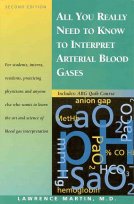Preface to 2nd Edition
Click on underlined chapters for full text excerpts
In the field of blood gas interpretation, not much has changed since
the first edition of this book (1992). The basic physiology is the same
of course, and the way the test is run is also little changed. A new
edition is nonetheless justified for several reasons.
First, there is the need to incorporate additional information on
non-invasive "blood gas" data, principally pulse oximetry measurement
of SpO2 and end-tidal PCO2 (PetCO2) monitoring. Both tests have now
become routine in the management of patients, the PetCO2 mainly in the
intensive care arena. These tests are largely responsible for a
nationwide decline in the number of arterial samples analyzed for blood
gas data. Indeed, it is now commonplace to manage stable,
mechanically-ventilated patients almost entirely without arterial blood
draws, using only non-invasive blood gas measurements. Expanded
coverage of this topic is included within the respective chapters on
PCO2 and oxygen saturation.
A new edition also provides opportunity to better explain some
important physiology. For example, in discussions with students and
physicians, I often encounter confusion about the crucial differences
between PaO2, SaO2 and oxygen content. The confusion is over how
they relate to each other, and to factors such as anemia,
carboxyhemoglobin and methemoglobin. This subject has been re-written and greatly expanded for clarity and emphasis. Likewise, the
section on anion gap and electrolytes has been expanded, with several
examples provided on use of the "bicarbonate gap" to uncover mixed
acid-base disorders.
I have also added a third "Putting it Altogether" chapter, on clinical
evaluation and test ordering. The two "Putting it Altogether" chapters
in the first edition gave blood gas data to interpret, but did not ask
"When is a blood gas necessary?" and "Can some other test substitute?"
The new chapter presents 16 brief patient scenarios, most without any
blood gas data, and you are asked to determine what gas exchange tests
should be obtained: e.g., complete arterial blood gas measurements?;
co-oximetry alone?; pulse oximetry alone?; none?
In the first edition I omitted discussion of venous blood gases since,
in my opinion, this is not information most clinicians really need to
know. Yet many students and clinicians want to learn about this topic,
even though they are seldom called on to interpret mixed venous blood
gases. For them I have added a chapter, "Venous Blood Gases:
Beyond All You Really Need to Know."
Other changes to this edition include more figures, expansion of the
pre- and post-blood gas quizzes, an enlarged bibliography, and an
internet address for our Pulmonary Medicine web site (see below).
As always, emphasis is on basic gas exchange physiology useful in
the care of patients. You will need a pencil to get the most out of this
book, but a calculator is not necessary (though it may speed problem
solving). If you do the exercises as they are presented, you cannot help
but learn "All You Really Need to Know to Interpret Arterial Blood
Gases." I will go one step further: if you read carefully through each
chapter and work on all the problems and exercises, you should acquire
sufficient expertise to teach the subject.
Lawrence Martin, M.D.
Cleveland
|

